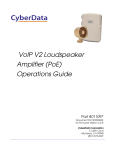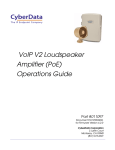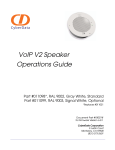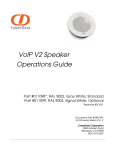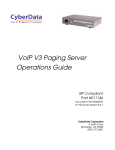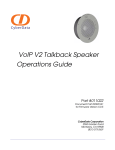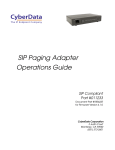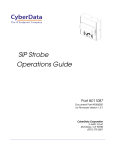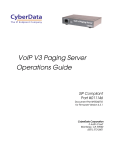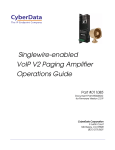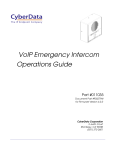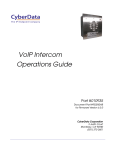Download CyberData 011061 Product specifications
Transcript
VoIP V2 Paging Amplifier Operations Guide Part #011061 Document Part #930324E for Firmware Version 6.0.0 CyberData Corporation 3 Justin Court Monterey, CA 93940 (831) 373-2601 VoIP V2 Paging Amplifier Operations Guide 930324E Part # 011061 COPYRIGHT NOTICE: © 2011, CyberData Corporation, ALL RIGHTS RESERVED. This manual and related materials are the copyrighted property of CyberData Corporation. No part of this manual or related materials may be reproduced or transmitted, in any form or by any means (except for internal use by licensed customers), without prior express written permission of CyberData Corporation. This manual, and the products, software, firmware, and/or hardware described in this manual are the property of CyberData Corporation, provided under the terms of an agreement between CyberData Corporation and recipient of this manual, and their use is subject to that agreement and its terms. DISCLAIMER: Except as expressly and specifically stated in a written agreement executed by CyberData Corporation, CyberData Corporation makes no representation or warranty, express or implied, including any warranty or merchantability or fitness for any purpose, with respect to this manual or the products, software, firmware, and/or hardware described herein, and CyberData Corporation assumes no liability for damages or claims resulting from any use of this manual or such products, software, firmware, and/or hardware. CyberData Corporation reserves the right to make changes, without notice, to this manual and to any such product, software, firmware, and/or hardware. OPEN SOURCE STATEMENT: Certain software components included in CyberData products are subject to the GNU General Public License (GPL) and Lesser GNU General Public License (LGPL) “open source” or “free software” licenses. Some of this Open Source Software may be owned by third parties. Open Source Software is not subject to the terms and conditions of the CyberData COPYRIGHT NOTICE or software licenses. Your right to copy, modify, and distribute any Open Source Software is determined by the terms of the GPL, LGPL, or third party, according to who licenses that software. Software or firmware developed by CyberData that is unrelated to Open Source Software is copyrighted by CyberData, subject to the terms of CyberData licenses, and may not be copied, modified, reverse-engineered, or otherwise altered without explicit written permission from CyberData Corporation. TRADEMARK NOTICE: CyberData Corporation and the CyberData Corporation logos are trademarks of CyberData Corporation. Other product names, trademarks, and service marks may be the trademarks or registered trademarks of their respective owners. Phone: (831) 373-2601 Technical Support Ext. 333 [email protected] Fax: (831) 373-4193 Company and product information at www.cyberdata.net Operations Guide 930324E CyberData Corporation Revision Information Revision 930324E, released on February 10, 2011, corresponds to firmware version 6.0.0 and has the following changes: • Updates Figure 2-3, "Paging Amplifier Components". The steps for announcing the IP address and restoring the factory default settings has changed. • Updates Figure 2-16, "Home Page". • Updates Figure 2-17, "Device Configuration Page". • Updates Figure 2-18, "Network Configuration Page". • Updates Figure 2-19, "SIP Configuration Page". • Updates Figure 2-20, "Nightringer Configuration Setup". • Updates Figure 2-21, "Sensor Configuration Page". • Updates Figure 2-22, "Multicast Configuration Setup". • Updates Figure 2-23, "Audio Configuration Page". • Updates Figure 2-29, "Event Configuration Page". • Updates Figure 2-30, "Autoprovisioning Configuration Page". • Updates Figure 2-31, "Firmware Upgrade Page". • Updates Figure 2-33, "Reboot Page". • Updates Section 2.2.1, "Paging Amplifier Components". The steps for announcing the IP address and restoring the factory default settings has changed. • Updates Section 2.2.5.1, "RTFM Switch". The steps for announcing the IP address and restoring the factory default settings has changed. • Updates Section 2.3.13, "Upgrade the Firmware and Reboot the Paging Amplifier". A TFTP server is no longer needed to upgrade the firmware. Operations Guide 930324E CyberData Corporation Important Safety Instructions 1. Read these instructions. 2. Keep these instructions. 3. Heed all warnings. 4. Follow all instructions. 5. Do not use this apparatus near water. 6. Clean only with dry cloth. 7. Do not block any ventilation openings. Install in accordance with the manufacturer’s instructions. 8. Do not install near any heat sources such as radiators, heat registers, stoves, or other apparatus (including amplifiers) that produce heat. 9. Do not defeat the safety purpose of the polarized or grounding-type plug. A polarized plug has two blades with one wider than the other. A grounding type plug has two blades and a third grounding prong. The wide blade or the third prong are provided for your safety. If the provided plug does not fit into your outlet, consult an electrician for replacement of the obsolete outlet. 10. Protect the power cord from being walked on or pinched particularly at plugs, convenience receptacles, and the point where they exit from the apparatus. 11. Only use attachments/accessories specified by the manufacturer. 12. Refer all servicing to qualified service personnel. Servicing is required when the apparatus has been damaged in any way, such as power-supply cord or plug is damaged, liquid has been spilled or objects have fallen into the apparatus, the apparatus has been exposed to rain or moisture, does not operate normally, or has been dropped. 13. Prior to installation, consult local building and electrical code requirements. Warning Electrical Hazard: This product should be installed by a licensed electrician according to all local electrical and building codes. GENERAL ALERT Warning Electrical Hazard: To prevent injury, this apparatus must be securely attached to the floor/wall in accordance with the installation instructions. GENERAL ALERT Operations Guide 930324E CyberData Corporation Pictorial Alert Icons GENERAL ALERT General Alert This pictoral alert indicates a potentially hazardous situation. This alert will be followed by a hazard level heading and more specific information about the hazard. Ground This pictoral alert indicates the Earth grounding connection point. Hazard Levels Danger: Indicates an imminently hazardous situation which, if not avoided, will result in death or serious injury. This is limited to the most extreme situations. Warning: Indicates a potentially hazardous situation which, if not avoided, could result in death or serious injury. Caution: Indicates a potentially hazardous situation which, if not avoided, could result in minor or moderate injury. It may also alert users against unsafe practices. Notice: Indicates a statement of company policy (that is, a safety policy or protection of property). The safety guidelines for the equipment in this manual do not purport to address all the safety issues of the equipment. It is the responsibility of the user to establish appropriate safety, ergonomic, and health practices and determine the applicability of regulatory limitations prior to use. Potential safety hazards are identified in this manual through the use of words Danger, Warning, and Caution, the specific hazard type, and pictorial alert icons. Operations Guide 930324E CyberData Corporation Abbreviations and Terms Operations Guide Abbreviation or Term Definition A-law A standard companding algorithm, used in European digital communications systems to optimize, i.e., modify, the dynamic range of an analog signal for digitizing. AVP Audio Video Profile Cat 5 TIA/EIA-568-B Category 5 DHCP Dynamic Host Configuration Protocol LAN Local Area Network LED Light Emitting Diode Mbps Megabytes per Second. NTP Network Time Protocol PBX Private Branch Exchange PoE Power over Ethernet (as per IEEE 802.3af standard) RTP Real-time Transport Protocol RTFM Reset Test Function Management SIP Session Initiated Protocol TFTP Trivial File Transfer Protocol u-law A companding algorithm, primarily used in the digital telecommunication UC Unified Communications VoIP Voice over Internet Protocol 930324E CyberData Corporation i Contents Chapter 1 Product Overview 1 1.1 How to Identify This Product ..............................................................................................................1 1.2 Typical System Installation ...................................................................................................................2 1.3 Product Features .....................................................................................................................................2 1.4 Supported Protocols ..............................................................................................................................3 1.5 Supported SIP Servers ...........................................................................................................................3 1.6 Product Specifications ...........................................................................................................................4 Chapter 2 Installing the VoIP V2 Paging Amplifier 5 2.1 Parts List ..................................................................................................................................................5 2.2 Paging Amplifier Setup .........................................................................................................................6 2.2.1 Paging Amplifier Components .................................................................................................7 2.2.2 Paging Amplifier DIP Switches ................................................................................................8 2.2.3 VoIP V2 Paging Amplifier System Installation and Connection Options ..........................9 2.2.4 Confirm Operation .................................................................................................................... 12 2.2.5 Confirm the IP Address and Test the Audio .........................................................................13 2.2.6 Adjust the Volume .................................................................................................................... 13 2.3 Configure the Paging Amplifier Parameters ...................................................................................15 2.3.1 Paging Amplifier Web Page Navigation ................................................................................ 16 2.3.2 Log in to the Configuration Home Page ................................................................................ 17 2.3.3 Configure the Device Parameters ...........................................................................................20 2.3.4 Configure the Network Parameters ...................................................................................... 23 2.3.5 Configure the SIP Parameters ................................................................................................. 25 2.3.6 Configure the Night Ringer Parameters ................................................................................ 27 2.3.7 Configure the Sensor Configuration Parameters .................................................................29 2.3.8 Configure the Multicast Configuration Parameters ............................................................ 31 2.3.9 Configure the Audio Parameters ............................................................................................35 2.3.10 User-created Audio Files ........................................................................................................ 40 2.3.11 Configure the Event Parameters ...........................................................................................42 2.3.12 Configure the Autoprovisioning Parameters ...................................................................... 47 2.3.13 Upgrade the Firmware and Reboot the Paging Amplifier ................................................52 2.3.14 Reboot the Paging Amplifier ................................................................................................. 55 Appendix A Mounting the Amplifier 56 A.1 Mount the Amplifier ......................................................................................................................... 56 Appendix B Setting up a TFTP Server 57 B.1 Set up a TFTP Server ........................................................................................................................... 57 B.1.1 In a LINUX Environment ........................................................................................................ 57 B.1.2 In a Windows Environment ................................................................................................... 57 Appendix C Troubleshooting/Technical Support 58 C.1 Frequently Asked Questions (FAQ) ................................................................................................. 58 C.2 Documentation .................................................................................................................................... 58 C.3 Contact Information ............................................................................................................................ 59 C.4 Warranty ............................................................................................................................................... 59 C.4.1 Warranty & RMA Returns within the United States ........................................................... 60 C.4.2 Warranty & RMA Returns Outside of the United States .................................................... 60 C.4.3 Spare in the Air Policy .............................................................................................................60 C.4.4 Return and Restocking Policy ................................................................................................ 60 C.4.5 Warranty and RMA Returns Page ......................................................................................... 60 Index Operations Guide 61 930324E CyberData Corporation 1 1 Product Overview The CyberData SIP-enabled VoIP V2 Paging Amplifier provides an easy method for implementing an IP-based overhead paging system for both new and legacy installations. With up to 25 watts of driving power (802.3at), the Amplifier provides direct drive of a standard Horn speaker and supports a line-out connector for connection to an external amplifier. The interface is compatible with most SIP-based IP PBX servers that comply with the SIP RFC 3261. For non-SIP environments, the Paging Amplifier can be configured to listen to multicast address and port number combinations to form paging zones. 1.1 How to Identify This Product To identify the VoIP V2 Paging Amplifier, look for a model number label similar to the one shown in Figure 1-1. The model number on the label should be 011061. Figure 1-1. Model Number Label WWW.CYBERDATA.NET AMPLIFIER,VoIP PAGING V2,PoE, INDOOR METAL ENCLOSURE,RoHS 011061A / 021047A 061000001 Model number Operations Guide 930324E CyberData Corporation Product Overview 2 Typical System Installation 1.2 Typical System Installation Figure 1-2 illustrates how the VoIP V2 Paging Amplifier is normally installed as part of a public address system. Figure 1-2. Typical Installation 802.3af Compliant Ethernet Switch 1 2 3 4 5 6 Paging Amplifier (up to 25 watts) 802.3at PoE Injector (High Power Mode with Injector) Loudspeaker (8 Ohm) Loudspeaker SIP Server VoIP Phone 1.3 Product Features • SIP (RFC 3261) compatible • Dual-speed ethernet 10/100 Mbps • Web-based configuration • Web-based firmware upgradeable • PoE 802.3at and 802.3af-enabled • IGMP • Line-out connector • DTMF controlled relay with open sense • Direct speaker drive • User-uploadable tones • Simultaneous SIP and Multicast • Autoprovisioning • Line-In capability • Nightringer Operations Guide 930324E CyberData Corporation Product Overview 3 Supported Protocols 1.4 Supported Protocols The V2 Paging Amplifier supports: • SIP • Multicast • HTTP Web-based configuration Provides an intuitive user interface for easy system configuration and verification of V2 Paging Amplifier operations. • DHCP Client Dynamically assigns IP addresses in addition to the option to use static addressing. • TFTP Client Facilitates hosting for the configuration file for Autoprovisioning. • RTP • RTP/AVP - Audio Video Profile • SPEEX • Audio Encodings PCMU (G.711 mu-law) PCMA (G.711 A-law) Packet Time 20 ms 1.5 Supported SIP Servers The following link contains information on how to configure the V2 Paging Amplifier for the supported SIP servers: http://www.cyberdata.net/support/server/index.html Operations Guide 930324E CyberData Corporation Product Overview 4 Product Specifications 1.6 Product Specifications Table 1. Product Specifications Category Specification Ethernet I/F 10/100 Mbps Power Input PoE 802.3at or 802.3af Operating Temperature -30 to 55 C (-22 to 131 F) Protocol SIP RFC 3261 Payload Types G711, SPEEX Regulatory Compliance FCC Class A, CE Warranty 2 Years Limited Dimensions 1.26” x 9.45” x 3.13” Audio Output 802.3af - up to 10 Watts (default, 50% duty cycle [one second on and one second off]). 802.3at - up to 22 Watts (default, 50% duty cycle [one second on and one second off]) Lineout: Operations Guide Output Signal Amplitudes 2.0 VPP maximum Output Level +2dBm nominal Total Harmonic Distortion 0.5% maximum Part Number 011061 930324E CyberData Corporation 5 2 Installing the VoIP V2 Paging Amplifier 2.1 Parts List Table 2-1 illustrates the parts for each Paging Amplifier and includes a kit for mounting. Table 2-1. Parts List Quantity Part Name 1 Paging Amplifier Assembly 1 Installation Quick Reference Guide 1 Paging Amplifier Mounting Accessory Kit, RoHS (part #071057A) which includes: Illustration (2)Plastic Ribbed Anchors (2) #6 Sheet Metal Screws Operations Guide 930324E CyberData Corporation Installing the VoIP V2 Paging Amplifier 6 Paging Amplifier Setup 2.2 Paging Amplifier Setup Set up and configure each Paging Amplifier before you mount it. CyberData delivers each Paging Amplifier with the factory default values indicated in Table 2-2: Table 2-2. Factory Default Settings—Default of Network Parameter Factory Default Setting IP Addressing IP Address DHCP a 10.10.10.10 Web Access Username admin Web Access Password admin Subnet Maska 255.0.0.0 Default Gatewaya 10.0.0.1 a. Default if there is not a DHCP server present. Operations Guide 930324E CyberData Corporation Installing the VoIP V2 Paging Amplifier 7 Paging Amplifier Setup 2.2.1 Paging Amplifier Components Figure 2-3 shows the components of the Paging Amplifier . Figure 2-3. Paging Amplifier Components DIP Switches RTFM Switch To broadcast a Paging Amplifier’s current IP address, press and hold the RTFM switch for a couple of seconds and then release it. To restore the factory defaults, complete the following steps: 1. Press and hold the RTFM switch until you hear the Paging Amplifier announce the words, “restoring defaults” and “rebooting”. 2. Release the RTFM switch. The Paging Amplifier will be restored to the factory default settings. Power LED (GREEN/BLUE) The power LED is a steady green in low power mode and a steady blue during high power mode. The power LED will only blink either during a boot up or a phone call. Status LED (GREEN) A steady LED confirms that the Paging Amplifier is operational. The LED will blink during a page when it is online. Network Activity LED (GREEN) Network Link LED (GREEN/YELLOW) Speaker Volume Operations Guide 930324E CyberData Corporation Installing the VoIP V2 Paging Amplifier 8 Paging Amplifier Setup 2.2.2 Paging Amplifier DIP Switches See Figure 2-4 to identify the DIP Switches. Figure 2-4. DIP Switches See Table 2-3 and Table 2-4 for the DIP Switch settings for the revision B (or later) board. Table 2-3. DIP Switch Settings—Low Power—802.3af Compliant (Default) DIP Switch Setting Description 1 OFF Sets PoE for 802.3af class. 2 N/A Not applicable for power setting. 3 ON Switch mode current set to LOW. 4 OFF Low gain amplifier setting. Table 2-4. DIP Switch Settings—High Power—Non-PoE Complianta DIP Switch Setting Description 1 ON Sets PoE for 802.3at class. 2 N/A Not applicable for power setting. 3 OFF Switch mode current set to HIGH. 4 ON Force high gain amplifier. a. If set to high power, the unit will not power ON with 802.3af compliant switch. You must use a power injector in this mode (CyberData part number 010867A). Table 2-5. DIP Switch 2 Settings Operations Guide DIP Switch Setting Description 2 OFF Manual Volume. The speaker volume is set manually by the analog volume trimmer. 2 ON Bypass. Bypasses the manual volume control of the analog volume trimmer and uses the web page volume settings. 930324E CyberData Corporation Installing the VoIP V2 Paging Amplifier 9 Paging Amplifier Setup 2.2.3 VoIP V2 Paging Amplifier System Installation and Connection Options The following figures show the connection options for the VoIP V2 Paging Amplifier. Figure 2-5. V2 Paging Amplifier Connections See Figure 2-6 See Figure 2-8 See Figure 2-9 See Figure 2-10 CLASS II WIRING See Figure 2-7 1-Sense (+) 2-GND 3-Relay COM 4-Relay NO 5-Line-In(+) 6-Line-In(-) 7-Line-Out(+) 8-Line-Out(-) 9-Spkr Out(+) 10-Spkr Out (-) Figure 2-6. Sensor Connection Paging Amplifier Figure 2-7. Relay or Strobe Alert Connection When the V2 Paging Amplifier is called from a remote phone, the relay on the paging amplifier can be programmed to blink and drive an Alert Strobe. +12V Strobe Relay Connection Paging Amplifier Figure 2-8. Line-In Connection When line-in is enabled on the V2 Paging Amplifier, the audio received from the line-in connection will be played to the speaker(s) and line-out connection as the lowest priority audio. Operations Guide Line Plug Paging Amplifier 930324E CyberData Corporation Installing the VoIP V2 Paging Amplifier 10 Paging Amplifier Setup Figure 2-9. Line Out Connection Line-Out Connection Generic Ethernet PoE Switch—802.3af 1 2 3 4 5 Line-Out is 10k Ohm at 2Vpp. Speaker output is 8 Ohm. 6 Line-out Connection Existing Loudspeaker Existing Amplifier IP Phone Paging Amplifier IP PBX Server Figure 2-10. Speaker Out Connection Speaker Connection 802.3af Compliant Ethernet Switch or 802.3at High Power PoE Switch 1 2 3 4 5 6 See the VoIP V2 Paging Amplifier Operations Guide for more information about the connections. 802.3at PoE Injector 011068 Loudspeaker (8 Ohm) Operations Guide Paging Amplifier (up to 25 watts) 930324E VoIP Phone IP PBX Server CyberData Corporation Installing the VoIP V2 Paging Amplifier 11 Paging Amplifier Setup See Table 2-6 for details about the Paging Amplifier connections. Table 2-6. Paging Amplifier Connections Connection Ethernet Connection Details ● Use a RJ 45 cable. Location VoIP V2 Paging Amplifier 2.2.3.1 Loudspeaker Type Using the amplified output, the CyberData VoIP V2 Paging Amplifier supports the 011068 Loudspeaker or equivalent unamplified loudspeaker. Figure 2-11. 011068 Loudspeaker 2.2.3.2 Cabling/Wiring Using the amplified output, you may connect a 011068 loudspeaker or equivalent unamplified speaker to a Paging Amplifier with good quality speaker wire that is 16 gauge and limited to 25 feet in length. Operations Guide 930324E CyberData Corporation Installing the VoIP V2 Paging Amplifier 12 Paging Amplifier Setup 2.2.4 Confirm Operation After connecting the Paging Amplifier to the ethernet hub, use the LEDs on the Paging Amplifier face to confirm that the Paging Amplifier is operational and linked to the network. Table 2-7. Paging Amplifier LEDs LED Color Function Power Blue/Green The power LED is illuminated a steady green when the power is on and in low power mode. The power LED is illuminated a steady blue when the amplifier is in high power mode. The power LED will blink during a boot up or a phone call. Status Green After supplying power to the Paging Amplifier, a steady LED confirms that the Paging Amplifier is operational. The status LED will blink during a page when it is online. Link Green/Yellow The Link LED is illuminated green for a 10Mb link or yellow/green for a 100Mb link when the network link to the Paging Amplifier is established. Activity Green The Activity LED blinks to indicate network traffic. Figure 2-12. Paging Amplifier LEDs—Power and Link Power LED (blue/green) Link LED (green/yellow) Figure 2-13. Paging Amplifier LEDs—Status and Activity Status LED (green) Activity LED (green)(yellow) Operations Guide 930324E CyberData Corporation Installing the VoIP V2 Paging Amplifier 13 Paging Amplifier Setup 2.2.5 Confirm the IP Address and Test the Audio 2.2.5.1 RTFM Switch When the Paging Amplifier is operational and linked to the network, use the Reset Test Function Management (RTFM) switch (Figure 2-14) on the Paging Amplifier face to announce and confirm the Paging Amplifier’s IP Address, and test the audio to make sure that it is working. Figure 2-14. RTFM Switch RTFM switch Announcing the IP To announce a Paging Amplifier’s current IP address: Address ● Press and hold the RTFM switch for a couple of seconds and then release it. Caution GENERAL ALERT Restoring the Factory Default Settings Equipment Caution: Pressing and holding the RTFM switch for more than five seconds will restore the V2 Paging Amplifier to the factory default settings. See the “Restoring the Factory Default Settings” section. To restore the factory default settings, complete the following steps: 1. Press and hold the RTFM switch until you hear the Paging Amplifier announce the words, “restoring defaults” and “rebooting”. 2. Release the RTFM switch. The Paging Amplifier will be restored to the factory default settings. 2.2.6 Adjust the Volume There are two ways to adjust the volume for the Paging Amplifier: Operations Guide • The Speaker Volume (0-9) setting on the Device Configuration page • The external Volume dial on the Paging Amplifier face 930324E CyberData Corporation Installing the VoIP V2 Paging Amplifier 14 Paging Amplifier Setup 2.2.6.1 The “Speaker Volume (0-9)” Setting To adjust the Paging Amplifier volume with the Speaker Volume (0-9) setting on the Device Configuration page, complete the following steps: 1. Make sure that dip switch 2 is set to ON. 2. Go to the Paging Amplifier Home page. 3. Select the Device Configuration page. 4. In the Speaker Volume (0-9) box, type a number between 0 (lowest) and 9 (highest). 5. Select Save. 6. Select Reboot. 2.2.6.2 The “Line-In Volume (0-9)” Setting To adjust the Paging Amplifier volume with the Line-In Playback Volume (0-9) setting on the Device Configuration page, complete the following steps: 1. Make sure that dip switch 2 is set to ON. 2. Go to the Paging Amplifier Home page. 3. Select the Device Configuration page. 4. In the Line-In Playback Volume (0-9) box, type a number between 0 (lowest) and 9 (highest). 5. Select Save. 6. Select Reboot. 2.2.6.3 External Volume Dial To adjust the Paging Amplifier volume with the external volume dial, complete the following steps: 1. Make sure that dip switch 2 is set to OFF. 2. Turn the external Volume dial (Figure 2-15) on the Paging Amplifier face. Note For the lineout volume, the volume is fixed and the volume control is adjusted through an external amplifier. Figure 2-15. External Volume Dial External volume dial Operations Guide 930324E CyberData Corporation Installing the VoIP V2 Paging Amplifier 15 Configure the Paging Amplifier Parameters 2.3 Configure the Paging Amplifier Parameters To configure the Paging Amplifier online, use a standard web browser. Configure each Paging Amplifier and verify its operation before you mount it. When you are ready to mount a Paging Amplifier enclosure, refer to Appendix A, "Mounting the Amplifier" for instructions. All Paging Amplifier are initially configured with the default IP settings indicated in Table 2-8. When configuring more than one Paging Amplifier, attach the Paging Amplifiers to the network one at a time to avoid IP address conflicts. Table 2-8. Factory Default Settings Parameter Factory Default Setting IP Addressing DHCP IP Addressa 10.10.10.10 Web Access Username admin Web Access Password admin Subnet Maska 255.0.0.0 Default Gatewaya 10.0.0.1 a. Default if there is not a DHCP server present. Operations Guide 930324E CyberData Corporation Installing the VoIP V2 Paging Amplifier 16 Configure the Paging Amplifier Parameters 2.3.1 Paging Amplifier Web Page Navigation Table 2-9 shows the navigation buttons that you will see on every Paging Amplifier web page. Table 2-9. V2 Paging Amplifier Web Page Navigation Web Page Item Description Link to the Home page. Link to the Device Configuration page. Link to the Networking page. Link to the SIP Configuration page. Link to the Nightringer page. Link to the Sensor Configuration page. Link to the Multicast Configuration page. Link to the Audio Configuration page. Link to the Event Configuration page. Link to the Autoprovisioning Configuration page. Link to the Update Firmware page. Operations Guide 930324E CyberData Corporation Installing the VoIP V2 Paging Amplifier 17 Configure the Paging Amplifier Parameters 2.3.2 Log in to the Configuration Home Page 1. Open your browser to the Paging Amplifier IP address. Note If the network does not have access to a DHCP server, the device will default to an IP address of 10.10.10.10. Note Make sure that the PC is on the same IP network as the Paging Amplifier. Note You may also download CyberData’s VoIP Discovery Utility program which allows you to easily find and configure the default web address of the CyberData VoIP products. CyberData’s VoIP Discovery Utility program is available on the VoIP V2 Paging Amplifier product page at: http://www.cyberdata.net/support/voip/discovery_utility.html The Paging Amplifier ships in DHCP mode. To get to the Home page, use the discovery utility to scan for the device on the network and open your browser from there. Operations Guide 930324E CyberData Corporation Installing the VoIP V2 Paging Amplifier 18 Configure the Paging Amplifier Parameters 2. When prompted, use the following default Web Access Username and Web Access Password to access the Home Page (Figure 2-16): Web Access Username: admin Web Access Password: admin Figure 2-16. Home Page Operations Guide 930324E CyberData Corporation Installing the VoIP V2 Paging Amplifier 19 Configure the Paging Amplifier Parameters 3. On the Home Page, review the setup details and navigation buttons described in Table 2-10. Table 2-10. Home Page Overview Web Page Item Description Device Settings Device Name Shows the device name (25 character limit). Change Username Type in this field to change the username (25 character limit). Change Password Type in this field to change the password (19 character limit). Re-enter Password Type the password again in this field to confirm the new password (19 character limit). Current Settings Serial Number Shows the device serial number. Mac Address Shows the device Mac address. Firmware Version Shows the current firmware version. IP Addressing Shows the current IP addressing setting (DHCP or Static). IP Address Shows the current IP address. Subnet Mask Shows the current subnet mask address. Default Gateway Shows the current default gateway address. DNS Server 1 Shows the current DNS Server 1 address. DNS Server 2 Shows the current DNS Server 2 address. Speaker Volume Shows the current Paging Amplifier volume mode: Digital (web page) or Analog (volume knob). High Power Mode is Shows the current status of High Power mode. SIP Mode is Shows the current status of the SIP Mode. Nightringer is Shows the current status of the Nightringer. Multicast Mode is Shows the current status of the Multicast Mode. Event Reporting is Shows the current status of the Event Reporting. Click the Save button to save your configuration settings. Note: You need to reboot for changes to take effect. Click on the Reboot button to reboot the system. Operations Guide 930324E CyberData Corporation Installing the VoIP V2 Paging Amplifier 20 Configure the Paging Amplifier Parameters 2.3.3 Configure the Device Parameters 1. Click the Device Configuration button to open the Device Configuration page. See Figure 2-17. Figure 2-17. Device Configuration Page Operations Guide 930324E CyberData Corporation Installing the VoIP V2 Paging Amplifier 21 Configure the Paging Amplifier Parameters 2. On the Device Configuration page, you may enter values for the parameters indicated in Table 2-11. Table 2-11. Device Configuration Parameters Web Page Item Description Volume Settings Speaker Volume Shows the current speaker volume mode (Analog or Digital) Speaker Volume (0-9) Type the desired Paging Amplifier volume level into this field (range is 0 - 9). Line-In Playback Volume (0-9) Type the desired line-in playback volume level into this field (range is 0 - 9). Relay Settings Activate Relay with DTMF Code When selected, the relay can be activated with a DTMF code. DTMF Activation Code Type the desired DTMF activation code (25 character limit). DTMF Activation Duration (in seconds) Type the desired DTMF activation duration (in seconds) (1 character limit). Activate Relay During Ring When selected, the relay will be activated for as long as the phone is ringing. NOTE: When the phone is set to Auto Answer, it will not ring and this option does nothing. Activate Relay During Night Ring When selected, the relay will be activated for as long as a night ring tone is playing. NOTE: When the phone is set to Auto Answer, it will not ring and this option does nothing. Activate Relay While Call Active When selected, the relay will be activated for as long as the call is active. Miscellaneous Settings Two Speakers Connected Select this option if two speakers are connected to the Paging Amplifier. Beep on Initialization When selected, you will hear a beep when the Paging Amplifier initializes. Auto-Answer Incoming Calls When selected, the Paging Amplifier automatically answers incoming calls. Play Ringback Tone Check this box to enable the device to play a ringtone while the remote device is ringing. Enable Line In Playback When selected, whatever audio source that you have selected (mp3 player, internet stream, etc.) will be played. Note: The line in audio will be treated as low priority audio that will only play if there is no other audio playing. When higher priority audio is playing, the line in audio will be muted. Click the Save button to save your configuration settings. Note: You need to reboot for changes to take effect. Operations Guide 930324E CyberData Corporation Installing the VoIP V2 Paging Amplifier 22 Configure the Paging Amplifier Parameters Table 2-11. Device Configuration Parameters (continued) Web Page Item Description Click on the Test Audio button to do an audio test. Generates a voice message for testing the device audio quality and volume. It plays the audio at the volume you have configured the paging amp for Note: If the test audio button is pressed while music is playing via the Enabled Line In feature, the music will be muted during the test audio message. Click on the Test Relay button to do a relay test. Click on the Reboot button to reboot the system. 3. After changing the parameters, click the Save button. Operations Guide 930324E CyberData Corporation Installing the VoIP V2 Paging Amplifier 23 Configure the Paging Amplifier Parameters 2.3.4 Configure the Network Parameters 1. Click the Networking button to open the Network Configuration page (Figure 2-18). Figure 2-18. Network Configuration Page Operations Guide 930324E CyberData Corporation Installing the VoIP V2 Paging Amplifier 24 Configure the Paging Amplifier Parameters 2. On the Network Configuration page, enter values for the parameters indicated in Table 2-12. Table 2-12. Network Configuration Parameters Web Page Item Description Stored Network Settings IP Addressing* Select either DHCP IP Addressing or Static IP Addressing by marking the appropriate radio button. If you select Static, configure the remaining parameters indicated in Table 2-12. If you select DHCP, go to Step 3. IP Address* Enter the Static IP address. Subnet Mask Enter the Subnet Mask address. Default Gateway Enter the Default Gateway address. DNS Server 1* Enter the DNS Server 1 address. DNS Server 2* Enter the DNS Server 2 address. Current Network Settings Shows the current network settings. IP Address Shows the current Static IP address. Subnet Mask Shows the current Subnet Mask address. Default Gateway Shows the current Default Gateway address. DNS Server 1 Shows the current DNS Server 1 address. DNS Server 2 Shows the current DNS Server 2 address. Click the Save button to save your configuration settings. Note: You need to reboot for changes to take effect. Click on the Reboot button to reboot the system. 3. After changing the parameters, click Save Settings. This updates the changed parameters and reboots the Paging Amplifier if appropriate. 4. Connect the Paging Amplifier to the target network. 5. From a system on the same network as the Paging Amplifier, open a browser with the new IP address of the Paging Amplifier. Operations Guide 930324E CyberData Corporation Installing the VoIP V2 Paging Amplifier 25 Configure the Paging Amplifier Parameters 2.3.5 Configure the SIP Parameters 1. Click SIP Config to open the SIP Configuration page (Figure 2-19). Note For specific server configurations, go to the IP-PBX Server Compatibility page at: http://www.cyberdata.net/support/server/index.html Figure 2-19. SIP Configuration Page 2. On the SIP Configuration page, you may enter values for the parameters indicated in Table 2-13. Table 2-13. SIP Configuration Parameters Operations Guide Web Page Item Description Enable SIP Operation Enables or disables SIP operation. 930324E CyberData Corporation Installing the VoIP V2 Paging Amplifier 26 Configure the Paging Amplifier Parameters Table 2-13. SIP Configuration Parameters (continued) Web Page Item Description SIP Settings SIP Server* Type the SIP server represented as either a numeric IP address in dotted decimal notation or the fully qualified host name (64 character limit [FQDN]). Remote SIP Port* Type the Remote SIP Port number (default 5060) (0 - 65535). Local SIP Port* Type the Local SIP Port number (default 5060) (0 - 65535). Outbound Proxy Type the Outbound Proxy as either a numeric IP address in dotted decimal notation or the fully qualified host name (64 character limit [FQDN]). Outbound Proxy Port Type the Outbound Proxy Port number (0 - 65535). SIP User ID* Type the SIP User ID (up to 25 alphanumeric characters). Authenticate ID* Type the Authenticate ID (up to 25 alphanumeric characters). Authenticate Password* Type the Authenticate Password (up to 25 alphanumeric characters). Register with a SIP Server* Enable or disable SIP Registration. Re-registration Interval (in seconds)* Type the SIP Registration lease time in seconds (default is 120 seconds) (range is 100 - ?). Unregister on Reboot* • When selected, the Paging Amplifier automatically unregisters when it is rebooted. • When not selected, the Paging Amplifier remains registered when it is rebooted. Buffer SIP Calls When this is enabled, SIP calls to the speaker will be stored in memory and will play when either the call is terminated or the buffer is full. The receive buffer is 2MB in size and this is equal to about four minutes of ulaw encoded audio. Beep Before Page Enable/Disable the tone (beep) before each page. RTP Settings RTP Port (even) Specify the port number used for the RTP stream after establishing a SIP call. The RTP port has to be an even number between 0 and 65534. This port can be programmed for people who are not working on a local LAN, but who want to have outside access. Instead of RTP port being a random port, it will be set up so that only two ports can be opened in a firewall. Note: The RTP port number has to be an even number because the control port is always one port number higher. Therefore, audio will go through the port number that you enter into the RTP port field, but the RTP control signals will go through a port that is one number higher than the RTP port field. Click the Save button to save your configuration settings. Note: You need to reboot for changes to take effect. Click on the Reboot button to reboot the system. 3. After changing the parameters, click Save to save the settings. Operations Guide 930324E CyberData Corporation Installing the VoIP V2 Paging Amplifier 27 Configure the Paging Amplifier Parameters 2.3.6 Configure the Night Ringer Parameters 1. Click on the Nightringer button to open the Nightringer Configuration page. See Figure 2-22. Figure 2-20. Nightringer Configuration Setup Operations Guide 930324E CyberData Corporation Installing the VoIP V2 Paging Amplifier 28 Configure the Paging Amplifier Parameters 2. On the Nightringer Configuration page, enter values for the parameters indicated in Table 2-16. Table 2-14. Nightringer Configuration Parameters Web Page Item Description Enable Nightringer When the nightringer is enabled, the device will attempt to register a second extension with the SIP server. Any calls made to this extension will play a ringtone. Nightringer Settings SIP Server Type the SIP server represented as either a numeric IP address in dotted decimal notation. Remote SIP Port Type the Remote SIP Port number (default 5060) (8 character limit). Local SIP Port Type the Local SIP Port number (default 5060) (8 character limit). Note: This value cannot be the same as the Local SIP Port* found on the SIP Configuration Page. User ID Type the User ID (up to 64 alphanumeric characters). Authenticate ID Type the Authenticate ID (up to 64 alphanumeric characters). Authenticate Password Type the Authenticate Password (up to 64 alphanumeric characters). Re-registration Interval (in seconds)* Type the SIP Registration lease time in minutes (default is 60 minutes) (8 character limit). Re-registration Interval (in seconds)* Click the Save button to save your configuration settings. Note: You need to reboot for changes to take effect. Click on the Reboot button to reboot the system. 3. After changing the parameters, click on the Save button. Operations Guide 930324E CyberData Corporation Installing the VoIP V2 Paging Amplifier 29 Configure the Paging Amplifier Parameters 2.3.7 Configure the Sensor Configuration Parameters The sensor (pins 1 and 2) on the header can be used to monitor something’s open or closed state. There is an option on the Sensor Configuration page to trigger on an open or short condition on these pins. For the sensor there are three actions that the Paging Amplifier can do: ● Activate the relay until the sensor is deactivated ● Loop an audio file until the sensor is deactivated ● Call a preset extension and play a pre-recorded audio file (loops until user hangs up) Note Calling a preset extension can be set up as a point-to-point call, but currently can't send delayed DTMF tones. 1. Click Sensor Config to open the Sensor Configuration page (Figure 2-21). Figure 2-21. Sensor Configuration Page Operations Guide 930324E CyberData Corporation Installing the VoIP V2 Paging Amplifier 30 Configure the Paging Amplifier Parameters 2. On the Sensor Configuration page, enter values for the parameters indicated in Table 2-15. Table 2-15. Sensor Configuration Parameters Web Page Item Description Sensor Settings Sensor Normally Closed Select the inactive state of the sensors. Activate Relay Check this box to activate the relay until the sensor is deactivated. Play Audio Locally Check this box to loop an audio file until the sensor is deactivated. Play Audio Remotely Check this box to make only one call to a preset extension and play a pre-recorded audio file repeatedly. Dial Out Extension Enter the dial-out extension number. Use this button to test the sensor. Click the Save button to save your configuration settings. Note: You need to reboot for changes to take effect. Click on the Reboot button to reboot the system. 3. After changing the parameters, click Save Settings. Operations Guide 930324E CyberData Corporation Installing the VoIP V2 Paging Amplifier 31 Configure the Paging Amplifier Parameters 2.3.8 Configure the Multicast Configuration Parameters Multicast groups use multicasting to create public address paging zones. Multicasting is based on the concept of a group. Multicast addresses specify an arbitrary group of IP hosts that have joined the group and want to receive traffic sent to the group. Group members send IGMP messages to their local multicast routers, allowing the group traffic traversal from the source. Multicast configuration provides the ability to join up to 10 paging zones. A paging zone can consist of one, or many, CyberData multicast group-enabled Paging Amplifiers. There is no limit to how many Paging Amplifiers can be in a given paging zone. Each multicast group is defined by a multicast address and port number. Each multicast group is also assigned a priority, allowing simultaneously arriving pages to be serviced based on importance. Multicast groups are compatible with IGMP through version 3. Note Operations Guide The Paging Amplifier supports simultaneous SIP and Multicast. 930324E CyberData Corporation Installing the VoIP V2 Paging Amplifier 32 Configure the Paging Amplifier Parameters 1. Click on the Multicast Configuration button to open the Multicast Configuration page. See Figure 2-22. Figure 2-22. Multicast Configuration Setup Operations Guide 930324E CyberData Corporation Installing the VoIP V2 Paging Amplifier 33 Configure the Paging Amplifier Parameters 2. On the Multicast Configuration page, enter values for the parameters indicated in Table 2-16. Table 2-16. Multicast Configuration Parameters Web Page Item Description Enable Multicast Operation Enables or disables multicast operation. Priority Indicates the priority for the multicast group. Priority 9 is the highest (emergency streams). 0 is the lowest (background music). See Section 2.3.8.1, "Assigning Priority" for more details. Address Enter the multicast IP Address for this multicast group (15 character limit). Port (range can be from 2000 to 65535) Enter the port number for this multicast group (5 character limit). Note: The multicast ports have to be even values. The webpage will enforce this restriction. Name Assign a descriptive name for this multicast group (25 character limit). Buffer When buffering is enabled for a multicast stream, it will store any audio received on this socket to memory and play it back when the stream is stopped or the buffer is full. Beep Enable or disable the tone (beep) for a multicast stream. Relay Enable or disable the relay for a multicast stream. Click the Save button to save your configuration settings. Note: You need to reboot for changes to take effect. Click on the Reboot button to reboot the system. 3. After changing the parameters, click on the Save button. Operations Guide 930324E CyberData Corporation Installing the VoIP V2 Paging Amplifier 34 Configure the Paging Amplifier Parameters 2.3.8.1 Assigning Priority When playing multicast streams, audio on different streams will preempt each other according to their priority in the list. An audio stream with a higher priority will interrupt a stream with a lower priority. If both SIP and Multicast is enabled, SIP audio streams are considered priority 4.5. SIP audio will interrupt multicast streams with priority 0 through 4 and will be interrupted by multicast streams with priority 5 through 9. During priority 9 multicast streams, the analog volume control is bypassed and the volume level is set to maximum. Line In audio is considered the lowest priority, so it will be muted if there are any multicast or SIP audio streams playing. For example, if the test audio button on the Device Config page is pressed while music is playing via the Enabled Line In feature, the music will be muted during the test audio message. Note Ringtones and Nightringtones SIP calls, buffered SIP calls, multicast streams, buffered multicast streams, ring tones, ringback tones, and nightring tones are all prioritized. Ringtones all play at the same priority level. This means that it is possible to have a nightring tone and a normal ringtone playing at the same time. The maximum ringtone duration is 2,097,152 bytes or about four minutes of ulaw audio. Lengthy Pages Concerning how lengthy pages are handled (where someone puts the phone down for 15 minutes), after the 2MB limit is reached, further data will be thrown away while the audio file is played back. When the file is done playing, it will stop throwing away input and begin buffering data for another four minutes. Therefore, with the buffered mode enabled on a stream playing background music, you will hear the following sequence of events: 1. Four minutes of silence. 2. Music from 0:00 through 4:00. 3. Four minutes of silence. 4. Music from 8:00 through 12:00 and so on. Buffered Audio Operations Guide When the device is playing back buffered audio and this buffered audio is interrupted by a higher priority stream, once the higher priority streams is finished, the device will restart the lower priority stream from the beginning. 930324E CyberData Corporation Installing the VoIP V2 Paging Amplifier 35 Configure the Paging Amplifier Parameters 2.3.9 Configure the Audio Parameters Click the Audio Config button to open the Audio Configuration page. The Audio Configuration page is used to add custom audio to the board. User uploaded audio will take precedence over the audio files shipped with the Paging Amplifier. Figure 2-23. Audio Configuration Page Operations Guide 930324E CyberData Corporation Installing the VoIP V2 Paging Amplifier 36 Configure the Paging Amplifier Parameters Figure 2-24. Audio Configuration Page (continued) Operations Guide 930324E CyberData Corporation Installing the VoIP V2 Paging Amplifier 37 Configure the Paging Amplifier Parameters Figure 2-25. Audio Configuration Page (continued) Operations Guide 930324E CyberData Corporation Installing the VoIP V2 Paging Amplifier 38 Configure the Paging Amplifier Parameters On the Audio Configuration page, enter values for the parameters indicated in Table 2-17. Note Each entry on the Audio Configuration page replaces one of the stock audio files on the board. When the input box displays the word default, the Paging Amplifier is using the stock audio file. If that file is replaced with a user file, it will display the uploaded filename. Table 2-17. Audio Configuration Parameters Web Page Item Description Audio Files 0-9 The name of the audio configuration option is the same as the spoken audio that plays on the board (24 character limit). '0' corresponds to the spoken word “zero.” '1' corresponds to the spoken word “one.” '2' corresponds to the spoken word “two.” '3' corresponds to the spoken word “three.” '4' corresponds to the spoken word “four.” '5' corresponds to the spoken word “five.” '6' corresponds to the spoken word “six.” '7' corresponds to the spoken word “seven.” '8' corresponds to the spoken word “eight.” '9' corresponds to the spoken word “nine.” Dot Corresponds to the spoken word “dot.” (24 character limit) Audiotest Corresponds to the message “This is the CyberData IP speaker test message...” (24 character limit) Pagetone Corresponds to a simple tone that is unused by default (24 character limit). Your IP Address is Corresponds to the message “Your IP address is...” (24 character limit). Rebooting Corresponds to the spoken word “Rebooting” (24 character limit). Restoring default Corresponds to the message “Restoring default” (24 character limit). Ringback Tone Corresponds to the ringback tone that plays when calling a remote extension (24 character limit). Ring Tone Corresponds to the tone that plays when set to ring when receiving a call (24 character limit). Sensor Triggered Corresponds to the sensor when it is triggered (24 character limit). Night Ring Specifies the ringtone for Night Ringer. By default this parameter uses the same audio file that is selected for the Ring Tone parameter. The Browse button will allow you to navigate to and select an audio file. The Play button will play that audio file. The Delete button will delete any user uploaded audio and restore the stock audio file. Operations Guide 930324E CyberData Corporation Installing the VoIP V2 Paging Amplifier 39 Configure the Paging Amplifier Parameters Table 2-17. Audio Configuration Parameters (continued) Web Page Item Description The Save button will download a new user audio file to the board once you've selected the file by using the Browse button. The Save button will delete any pre-existing user-uploaded audio files. Operations Guide 930324E CyberData Corporation Installing the VoIP V2 Paging Amplifier 40 Configure the Paging Amplifier Parameters 2.3.10 User-created Audio Files User created audio files should be saved in the following format: RIFF (little-endian) data, WAVE audio, Microsoft PCM, 16 bit, mono 8000 Hz You can use the free utility Audacity to convert audio files into this format. See Figure 2-26 through Figure 2-28. Figure 2-26. Audacity 1 Figure 2-27. Audacity 2 Operations Guide 930324E CyberData Corporation Installing the VoIP V2 Paging Amplifier 41 Configure the Paging Amplifier Parameters When you export an audio file with Audacity, save the output as: ● WAV (Microsoft) signed 16 bit PCM. Figure 2-28. WAV (Microsoft) signed 16 bit PCM WAV (Microsoft) signed 16 bit PCM Operations Guide 930324E CyberData Corporation Installing the VoIP V2 Paging Amplifier 42 Configure the Paging Amplifier Parameters 2.3.11 Configure the Event Parameters Click the Event Config button to open the Event Configuration page (Figure 2-29). The Event Configuration page specifies a remote server that can be used to receive HTTP POST events when actions take place on the board. Figure 2-29. Event Configuration Page Operations Guide 930324E CyberData Corporation Installing the VoIP V2 Paging Amplifier 43 Configure the Paging Amplifier Parameters Table 2-18 shows the web page items on the Event Configuration page. Table 2-18. Event Configuration Web Page Item Description Enable Event Generation When selected, Event Generation is enabled. Remote Event Server Remote Event Server IP Type the Remote Event Server IP address. (64 character limit) Remote Event Server Port Type the Remote Event Server port number. (0 - 65535) Remote Event Server URL Type the Remote Event Server URL. (127 character limit) Events Enable Call Active Events When selected, Call Active Events are enabled. Enable Call Terminated Events When selected, Call Terminated Events are enabled. Enable Relay Activated Events When selected, Relay Activated Events are enabled. Enable Relay Deactivated Events When selected, Relay Deactivated Events are enabled. Enable Ring Events When selected, Ring Events are enabled. Enable Night Ring Events When selected, there is a notification when the device receives a night ring. Enable Multicast Start Events When selected, Multicast Start Events are enabled. Enable Multicast Stop Events When selected, Multicast Stop Events are enabled. Enable Power On Events When selected, Power On Events are enabled. Enable 60 Second Heartbeat Events When selected, 60 Second Heartbeat Events are enabled. Click the Save button to save your configuration settings. Note: You need to reboot for changes to take effect. Click on the Test Event button to test an event. Click on the Reboot button to reboot the system. Operations Guide 930324E CyberData Corporation Installing the VoIP V2 Paging Amplifier 44 Configure the Paging Amplifier Parameters 2.3.11.1 Example Packets for Events The server and port are used to point to the listening server and the 'Remote Event Server URL' is the destination URL (typically the script running on the remote server that's used to parse and process the POST events). Note The XML is URL-encoded before transmission so the following examples are not completely accurate. Here are example packets for every event: POST xmlparse_engine HTTP/1.1 Host: 10.0.3.79 User-Agent: CyberData/1.0.0 Content-Length: 197 Content-Type: application/x-www-form-urlencoded <?xml version="1.0" encoding="ISO-8859-1"?> <cyberdata NAME='CyberData VoIP Device' MAC='0020f70015b6'> <event>POWERON</event> </cyberdata> POST xmlparse_engine HTTP/1.1 Host: 10.0.3.79 User-Agent: CyberData/1.0.0 Content-Length: 199 Content-Type: application/x-www-form-urlencoded <?xml version="1.0" encoding="ISO-8859-1"?> <cyberdata NAME='CyberData VoIP Device' MAC='0020f70015b6'> <event>HEARTBEAT</event> </cyberdata> POST xmlparse_engine HTTP/1.1 Host: 10.0.3.79 User-Agent: CyberData/1.0.0 Content-Length: 196 Content-Type: application/x-www-form-urlencoded <?xml version="1.0" encoding="ISO-8859-1"?> <cyberdata NAME='CyberData VoIP Device' MAC='0020f70015b6'> <event>BUTTON</event> </cyberdata> POST xmlparse_engine HTTP/1.1 Host: 10.0.3.79 User-Agent: CyberData/1.0.0 Content-Length: 201 Content-Type: application/x-www-form-urlencoded <?xml version="1.0" encoding="ISO-8859-1"?> <cyberdata NAME='CyberData VoIP Device' MAC='0020f70015b6'> <event>CALL_ACTIVE</event> </cyberdata> POST xmlparse_engine HTTP/1.1 Host: 10.0.3.79 Operations Guide 930324E CyberData Corporation Installing the VoIP V2 Paging Amplifier 45 Configure the Paging Amplifier Parameters User-Agent: CyberData/1.0.0 Content-Length: 205 Content-Type: application/x-www-form-urlencoded <?xml version="1.0" encoding="ISO-8859-1"?> <cyberdata NAME='CyberData VoIP Device' MAC='0020f70015b6'> <event>CALL_TERMINATED</event> </cyberdata> POST xmlparse_engine HTTP/1.1 Host: 10.0.3.79 User-Agent: CyberData/1.0.0 Content-Length: 197 Content-Type: application/x-www-form-urlencoded <?xml version="1.0" encoding="ISO-8859-1"?> <cyberdata NAME='CyberData VoIP Device' MAC='0020f70015b6'> <event>RINGING</event> </cyberdata> POST xmlparse_engine HTTP/1.1 Host: 10.0.3.79 User-Agent: CyberData/1.0.0 Content-Length: 234 Content-Type: application/x-www-form-urlencoded <?xml version="1.0" encoding="ISO-8859-1"?> <cyberdata NAME='CyberData VoIP Device' MAC='0020f70015b6'> <event>MULTICAST_START</event> <index>8</index> </cyberdata> POST xmlparse_engine HTTP/1.1 Host: 10.0.3.79 User-Agent: CyberData/1.0.0 Content-Length: 233 Content-Type: application/x-www-form-urlencoded <?xml version="1.0" encoding="ISO-8859-1"?> <cyberdata NAME='CyberData VoIP Device' MAC='0020f70015b6'> <event>MULTICAST_STOP</event> <index>8</index> </cyberdata> POST xmlparse_engine HTTP/1.1 Host: 10.0.3.79 User-Agent: CyberData/1.0.0 Content-Length: 234 Content-Type: application/x-www-form-urlencoded <?xml version="1.0" encoding="ISO-8859-1"?> <cyberdata NAME='CyberData VoIP Device' MAC='0020f70015b6'> <event>RELAY_ACTIVATED</event> </cyberdata> POST xmlparse_engine HTTP/1.1 Host: 10.0.3.79 Operations Guide 930324E CyberData Corporation Installing the VoIP V2 Paging Amplifier 46 Configure the Paging Amplifier Parameters User-Agent: CyberData/1.0.0 Content-Length: 234 Content-Type: application/x-www-form-urlencoded <?xml version="1.0" encoding="ISO-8859-1"?> <cyberdata NAME='CyberData VoIP Device' MAC='0020f70015b6'> <event>RELAY_DEACTIVATED</event> </cyberdata> POST xmlparse_engine HTTP/1.1 Host: 10.0.3.79 User-Agent: CyberData/1.0.0 Content-Length: 234 Content-Type: application/x-www-form-urlencoded <?xml version="1.0" encoding="ISO-8859-1"?> <cyberdata NAME='CyberData VoIP Device' MAC='0020f70015b6'> <event>NIGHTRINGING</event> </cyberdata> Operations Guide 930324E CyberData Corporation Installing the VoIP V2 Paging Amplifier 47 Configure the Paging Amplifier Parameters 2.3.12 Configure the Autoprovisioning Parameters 1. Click the Autoprovisioning button to open the Autoprovisioning Configuration page. See Figure 2-17. Figure 2-30. Autoprovisioning Configuration Page Operations Guide 930324E CyberData Corporation Installing the VoIP V2 Paging Amplifier 48 Configure the Paging Amplifier Parameters 2. On the Autoprovisioning Configuration page, you may enter values for the parameters indicated in Table 2-11. Table 2-19. Autoprovisioning Configuration Parameters Web Page Item Description Autoprovisioning Enable Autoprovisioning See Section 2.3.12.1, "Autoprovisioning". Get Autoprovisioning from DHCP See Section 2.3.12.1, "Autoprovisioning". Autoprovisioning Server (IP Address) See Section 2.3.12.1, "Autoprovisioning" (15 character limit). Autoprovisioning Autoupdate (in minutes) Type the desired time (in minutes) that you want the Autoprovisioning feature to update (6 character limit). Click the Save button to save your configuration settings. Note: You need to reboot for changes to take effect. Click on the Reboot button to reboot the system. 3. After changing the parameters, click the Save button. Operations Guide 930324E CyberData Corporation Installing the VoIP V2 Paging Amplifier 49 Configure the Paging Amplifier Parameters 2.3.12.1 Autoprovisioning Enable Autoprovisioning Option With autoprovisioning enabled, the board will get its configuration from a remote TFTP server on startup or periodically on a scheduled delay. Autoprovisioned values will override values stored in on-board memory and will be visible on the web page. The board gets its autoprovisioning information from an XML-formatted file hosted from a TFTP server. CyberData will provide a template for this XML file and the user can modify it for their own use. To use autoprovisioning, create a copy of the autoprovisioning template with the desired settings and name this file with the mac address of the device to configure (for example: 0020f7350058.config). Put this file into your TFTP server directory and manually set the TFTP server address on the board. It is not necessary to set every option found in the autoprovisioning template. As long as the XML is valid, the file can contain any subset. Options not autoprovisioned will default to the values stored in the on board memory. For example if you only wanted to modify the device name, the following would be a valid autoprovisioning file: <?xml version="1.0" encoding="utf-8" ?> <specific> <MiscSettings> <DeviceName>auto V2 Paging Amplifier</DeviceName> </MiscSettings> </specific> Networking The board will only apply networking settings or firmware upgrades after a reboot. Get Autoprovisioning from DHCP When this option is checked, the device will automatically fetch its autoprovisioning server address from the DHCP server. The device will use the address specified in OPTION 150 (TFTP-servername) or OPTION 66. If both options are set, the device will use OPTION 150. Refer to the documentation of your DHCP server for setting up OPTION 150. Operations Guide 930324E CyberData Corporation Installing the VoIP V2 Paging Amplifier 50 Configure the Paging Amplifier Parameters To set up a Linux DHCPD server to serve autoprovisioning information (in this case using both option 66 and 150), here's an example dhcpd.conf: # dhcpd.conf # # Configuration file for ISC dhcpd (see 'man dhcpd.conf') # ddns-update-style ad-hoc; option option-150 code 150 = ip-address; subnet 10.0.0.0 netmask 255.0.0.0 { max-lease-time 120; default-lease-time 120; option routers option subnet-mask 10.0.0.1; 255.0.0.0; option domain-name option domain-name-servers "voiplab"; 10.0.0.1; option time-offset -8; option tftp-server-name "10.0.0.254"; option option-150 10.0.0.254; # Pacific Standard Time range 10.10.0.1 10.10.2.1;} Autoprovisioning Instead of using DHCP to provide the autoprovisioning tftp server address, you can specify an Server (IP Address) address manually. Autoprovisioning Autoupdate If Autoprovisioning is enabled and the Autoprovisioning Autoupdate value is something other than 0 minutes, a service is started on startup that will wait the configured number of minutes and then try to re-download its autoprovisioning file. It will compare its previously autoprovisioned file with this new file and if there are differences, it will reboot the board. Autoprovisioned An Autoprovisioned firmware upgrade only happens after a reboot, will take roughly three Firmware Upgrades minutes, and the web page will be unresponsive during this time. The 'FirmwareVersion' value in the xml file must match the version stored in the 'FirmwareFile'. <FirmwareVersion>v5.0.5b01</FirmwareVersion> <FirmwareFile>505b01-uImage-ceilingspeak</FirmwareFile> If these values are mismatched, the board can get stuck in a loop where it goes through the following sequence of actions: 1. The board downloads and writes a new firmware file. 2. After the next reboot, the board recognizes that the firmware version does not match. 3. The board downloads and writes the firmware file again. CyberData has timed a firmware upgrade at 140 seconds. Therefore, if you suspect the board is stuck in a loop, either remove or comment out the FirmwareVersion line in the XML file and let the board boot as it normally does. Operations Guide 930324E CyberData Corporation Installing the VoIP V2 Paging Amplifier 51 Configure the Paging Amplifier Parameters Autoprovisioned Audio Files Audio files are stored in non-volatile memory and an autoprovisioned audio file will only have to be downloaded once for each device. Loading many audio files to the device from the web page could cause it to appear unresponsive. If this happens, wait until the transfer is complete and then refresh the page. The device uses the file name to determine when to download a new audio file. This means that if you used autoprovisioning to upload a file and then changed the contents of this file at the TFTP server, the device will not recognize that the file has changed (because the file name is the same). Since audio files are stored in non-volatile memory, if autoprovisioning is disabled after they have been loaded to the board, the audio file settings will not change. You can force a change to the audio files on the board by clicking Restore Default on the Audio Configuration page or by changing the autoprovisioning file with “default” set as the file name. Operations Guide 930324E CyberData Corporation Installing the VoIP V2 Paging Amplifier 52 Configure the Paging Amplifier Parameters 2.3.13 Upgrade the Firmware and Reboot the Paging Amplifier To upload the Paging Amplifier firmware from your PC: 1. Retrieve the latest Paging Amplifier firmware from the VoIP V2 Paging Amplifier Downloads page at: http://www.cyberdata.net/products/voip/digitalanalog/pagingampv2/downloads.html 2. Unzip the Paging Amplifier version file. This file may contain the following: • Firmware file • Release notes 3. Log in to the Paging Amplifier home page as instructed in Section 2.3.2, "Log in to the Configuration Home Page". Operations Guide 930324E CyberData Corporation Installing the VoIP V2 Paging Amplifier 53 Configure the Paging Amplifier Parameters 4. Click the Update Firmware button to open the Upgrade Firmware page. See Figure 2-31. Figure 2-31. Firmware Upgrade Page 5. Click Browse, and then navigate to the location of the Paging Amplifier firmware file. 6. Click Submit. Note Operations Guide This starts the upload process. Once the Paging Amplifier has uploaded the file, the Uploading Firmware countdown page appears, indicating that the firmware is being written to flash. The Paging Amplifier will automatically reboot when the upload is complete. When the countdown finishes, the Upgrade Firmware page will refresh. The uploaded firmware filename should be displayed in the system configuration (indicating successful upload and reboot). 930324E CyberData Corporation Installing the VoIP V2 Paging Amplifier 54 Configure the Paging Amplifier Parameters Table 2-20 shows the web page items on the Upgrade Firmware page. Table 2-20. Firmware Upgrade Parameters Web Page Item Description Firmware Version Shows the current firmware version. Use the Browse button to navigate to the location of the Intercom firmware file that you want to upload. Click on the Submit button to automatically upload the selected firmware and reboot the system. Click on the Reboot button to reboot the system. Operations Guide 930324E CyberData Corporation Installing the VoIP V2 Paging Amplifier 55 Configure the Paging Amplifier Parameters 2.3.14 Reboot the Paging Amplifier To reboot a Paging Amplifier, log in to the web page as instructed in Section 2.3.2, "Log in to the Configuration Home Page". 1. Click Update Firmware to open the Upgrade Firmware page (Figure 2-32). Figure 2-32. Upgrade Firmware Page Reboot 2. Click Reboot. A normal restart will occur and you will see the following Reboot page. Figure 2-33. Reboot Page Operations Guide 930324E CyberData Corporation 56 Appendix A: Mounting the Amplifier A.1 Mount the Amplifier Before you mount the enclosure, make sure that you have received all of the parts for each enclosure. Refer to Table A-21. Table A-21. Wall Mounting Components (Part of the Accessory Kit) Operations Guide Quantity Part Name 2 Plastic Ribbed Anchors 2 #6 Sheet Metal Screws Illustration Note The V2 Paging Amplifier was designed for indoor use. Mounting it on the external part of a building will require additional hardware for weatherproofing, cabling access, and lightning suppression. Consult a certified electrician for details. Note For mounting, use the two #6 SHEET METAL SCREWS to secure the enclosure. 930324E CyberData Corporation 57 Appendix B: Setting up a TFTP Server B.1 Set up a TFTP Server Autoprovisioning requires a TFTP server for hosting the configuration file. B.1.1 In a LINUX Environment To set up a TFTP server on LINUX: 1. Create a directory dedicated to the TFTP server, and move the files to be uploaded to that directory. 2. Run the following command where /tftpboot/ is the path to the directory you created in Step 1: the directory that contains the files to be uploaded. For example: in.tftpd -l -s /tftpboot/your_directory_name B.1.2 In a Windows Environment You can find several options online for setting up a Windows TFTP server. This example explains how to use the Solarwinds freeware TFTP server, which you can download at: http://www.cyberdata.net/support/voip/solarwinds.html To set up a TFTP server on Windows: 1. Install and start the software. 2. Select File/Configure/Security tab/Transmit Only. 3. Make a note of the default directory name, and then move the firmware files to be uploaded to that directory. Operations Guide 930324E CyberData Corporation 58 Appendix C: Troubleshooting/Technical Support C.1 Frequently Asked Questions (FAQ) To see a list of frequently asked questions for your product, do the following: 1. Go to the following URL: http://www.cyberdata.net/products/voip/digitalanalog/pagingampv2/faqs.html 2. Go to the support page for your product, and click on the FAQs tab. C.2 Documentation The documentation for this product is released in an English language version only. You can download PDF copies of CyberData product documentation by doing the following: 1. Go to the following URL: http://www.cyberdata.net/products/voip/digitalanalog/pagingampv2/docs.html 2. Go to the support page for your product, and click on the Documentation tab. Operations Guide 930324E CyberData Corporation 59 Contact Information C.3 Contact Information Contact CyberData Corporation 3 Justin Court Monterey, CA 93940 USA www.CyberData.net Phone: 800-CYBERDATA (800-292-3732) Fax: 831-373-4193 Sales Sales 831-373-2601 Extension 334 Technical Support Phone: 831-373-2601 Extension 333 Web: http://www.cyberdata.net/support/contactsupportvoip.html Returned Materials Authorization To return the product, contact the CyberData Returned Materials Authorization (RMA) department at: Phone: 831-373-2601, Extension 136 Email: [email protected] When returning a product to CyberData, an approved CyberData RMA number must be printed on the outside of the original shipping package. No product will be accepted for return without an approved RMA number. Send the product, in its original package, to the following address: CyberData Corporation 3 Justin Court Monterey, CA 93940 Attention: RMA "your RMA number" RMA Status Form If you need to inquire about the repair status of your product(s), please use the CyberData RMA Status form at the following web address: http://www.cyberdata.net/support/rmastatus.html C.4 Warranty CyberData warrants its product against defects in material or workmanship for a period of two years from the date of purchase. Should the product fail within the warranty period, CyberData will repair or replace the product free of charge. This warranty includes all parts and labor. Should the product fail out-of-warranty, a flat rate repair charge of one half of the purchase price of the product will be assessed. Repairs that are in warranty but are damaged by improper modifications or abuse, will be charged at the out-of-warranty rate. Products shipped to CyberData, both in and out-of-warranty, are shipped at the expense of the customer. Shipping charges for repaired products shipped back to the customer by CyberData, will be paid by CyberData. CyberData shall not under any circumstances be liable to any person for any special, incidental, indirect or consequential damages, including without limitation, damages resulting from use or malfunction of the products, loss of profits or revenues or costs of replacement goods, even if CyberData is informed in advance of the possibility of such damages. Operations Guide 930324E CyberData Corporation 60 Warranty C.4.1 Warranty & RMA Returns within the United States If service is required, you must contact CyberData Technical Support prior to returning any products to CyberData. Our Technical Support staff will determine if your product should be returned to us for further inspection. If Technical Support determines that your product needs to be returned to CyberData, an RMA number will be issued to you at this point. Your issued RMA number must be printed on the outside of the shipping box. No product will be accepted for return without an approved RMA number. The product in its original package should be sent to the following address: CyberData Corporation 3 Justin Court. Monterey, CA 93940 Attn: RMA "xxxxxx" C.4.2 Warranty & RMA Returns Outside of the United States If you purchased your equipment through an authorized international distributor or reseller, please contact them directly for product repairs. C.4.3 Spare in the Air Policy CyberData now offers a Spare in the Air no wait policy for warranty returns within the United States and Canada. More information about the Spare in the Air policy is available at the following web address: http://www.cyberdata.net/support/warranty/spareintheair.html C.4.4 Return and Restocking Policy For our authorized distributors and resellers, please refer to your CyberData Service Agreement for information on our return guidelines and procedures. For End Users, please contact the company that you purchased your equipment from for their return policy. C.4.5 Warranty and RMA Returns Page The most recent warranty and RMA information is available at the CyberData Warranty and RMA Returns Page at the following web address: http://www.cyberdata.net/support/warranty/index.html Operations Guide 930324E CyberData Corporation 61 Index Current Network Settings 24 current network settings 24 CyberData contact information 59 Symbols #6 sheet metal screws 56 D A default gateway 6, 15 IP address 6, 15 subnet mask 6, 15 username and password 6, 15 web login username and password 18 default gateway 6, 15, 24 default IP settings 15 default login address 17 device configuration device configuration parameters 48 the device configuration page 47 device configuration page 20 device configuration parameters 21 DHCP Client 3 DHCP IP addressing 24 dial out extension (door sensor) 30 discovery utility program 17 DNS server 24 door sensor 29, 38 activate relay 30 dial out extension 30 play audio locally 30 play audio remotely 30 accessory kit 5 activate relay (door sensor) 30 activity LED 12 address, configuration login 17 announcing an IP address 13 audio (buffered) 34 audio configuration 35 night ring tone parameter 38 audio configuration page 35 audio encodings 3 autoprovisioning 47, 49 autoprovisioned audio files 51 autoprovisioned firmware upgrades 50 autoprovisioning autoupdate 50 autoprovisioning enabled option 49 autoprovisioning from DHCP 49 autoprovisioning server (IP address) 50 networking 49 autoprovisioning configuration 48 B buffered audio 34 E C enable night ring events 43 enclosure, mounting 56 event configuration enable night ring events 43 expiration time for SIP server lease 26, 28 cabling 11 configurable parameters 19, 21 configuration default IP settings 15 door sensor 29 intrusion sensor 29 network 23 SIP 25 using Web interface 15 configuration home page 18 configuration page configurable parameters 19, 21 contact information 59 contact information for CyberData 59 Operations Guide F factory defaults 7, 13 firmware where to get the latest firmware 52 firmware upgrade parameters 54 930324E CyberData Corporation 62 H O hazard levels 5 home page 18 http web-based configuration 3 outbound proxy 26 P I packet time 3 pages (lengthy) 34 parts list 5 password for SIP server login 26 login 18 restoring the default 6, 15 play audio locally (door sensor) 30 play audio remotely (door sensor) 30 port local SIP 26 remote SIP 26 power LED 12 priority assigning 34 product configuring 15 mounting 56 parts list 5 product features 2 product overview product features 2 product specifications 4 supported protocols 3 supported SIP servers 3 typical system installation 2 product specifications 4 protocols supported 3 identifying your product 1 illustration of amplifier mounting process 56 installation 2 IP address 6, 15, 24 IP addressing 24 default IP addressing setting 6, 15 L lease, SIP server expiration time 26, 28 LEDs 12 lengthy pages 34 link LED 12 Linux, setting up a TFTP server on 57 local SIP port 26 log in address 17 loudspeaker, cabling/wiring 11 loudspeaker, type 11 M MGROUP MGROUP Name 33 mounting an amplifier 56 multicast configuration 31 Multicast IP Address 33 R reboot 54, 55 registration and expiration, SIP server lease 26 remote SIP port 26 reset test function management switch 13 resetting the IP address to the default 56 restoring the factory defaults 7, 13 return and restocking policy 60 ringtones 34 lengthy pages 34 RMA returned materials authorization 59 RMA status 59 RTFM switch 7, 13 RTP port 26 RTP/AVP 3 N navigation (web page) 16 navigation table 16 network configuration of intercom 23 network link activity, verifying 12 Network Setup 23 nightring tones 34 Nightringer 27 nightringer settings 28 Operations Guide 930324E CyberData Corporation 63 S V safety instructions 4 sales 59 sensor sensor normally closed 30 sensor settings 30 sensor setup page 29 sensor setup parameters 29 server address, SIP 26 service 59 SIP enable SIP operation 25 local SIP port 26 user ID 26 SIP (session initiation protocol) 3 SIP configuration 25 SIP Server 26 SIP configuration parameters registration and expiration, SIP server lease 28 SIP registration 26 SIP remote SIP port 26 SIP server 26 password for login 26 SIP servers supported 3 unregister from 26 user ID for login 26 SIP settings 26 Spare in the Air Policy 60 speaker cable 11 speaker wire 11 static IP addressing 24 status LED 12 subnet mask 6, 15, 24 supported protocols 3 verifying network link and activity 12 power on 12 volume 14 volume dial 14 W warranty 59 warranty & RMA returns outside of the United States 60 warranty & RMA returns within the United States 60 warranty and RMA returns page 60 warranty policy at CyberData 59 web access password 6, 15 web access username 6, 15 web configuration log in address 17 web page navigation 16 web page navigation 16 web-based paging amplifier configuration 15 Windows, setting up a TFTP server on 57 wiring 11 T tech support 59 technical support, contact information 59 test audio button 22 TFTP server 3, 57 U user ID for SIP server login 26 user ID, SIP 26 username default for web configuration access 18 restoring the default 6, 15 Operations Guide 930324E CyberData Corporation






































































